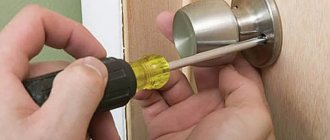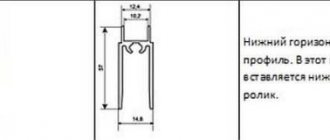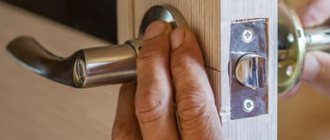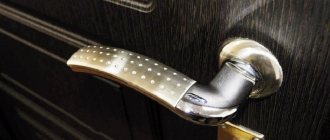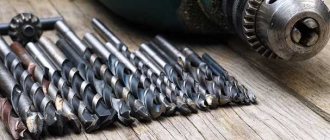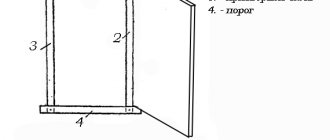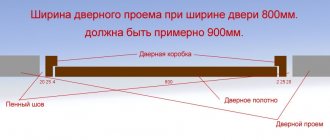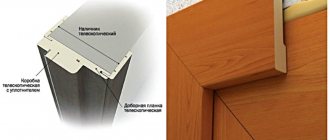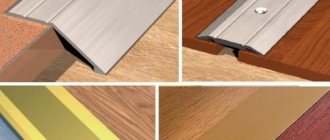Even the highest quality interior doors require maintenance and periodic replacement of hardware. Considering the frequency of opening and closing the door structure, the handle experiences the greatest load. It's easy to replace the part yourself. The main thing is to understand how door handles work. And also know what is needed to properly dismantle and reinstall the accessory.
Types of door handles
Handles for door blocks are selected depending on the type of room, degree of traffic, ease of fixation, design and price.
There are 2 classifications of locking fittings:
- According to the material. For the manufacture of handles, silumin, tempered glass, aluminum, steel, wood, and metal-plastic are used.
- According to design features. This parameter divides the fittings into rotary, push, and stationary.
- Push models consist of two L-shaped levers. They are connected to each other by means of a steel rod passing through the door leaf. The design is equipped with a tongue that fits into the hole in the door frame and acts as a locking mechanism. Lever handles have an extensive service life and high reliability.
- The rotary type is produced in the form of a ball or button. The standard diameter of the device is 5–6 cm. There is a keyhole in the center. It can be on one side or on both. Knobs are usually equipped with blockers and installed at the entrance to the toilet or bathhouse. They are characterized by insufficient strength and quickly fail. One of the reasons is the many small details.
- Stationary models have the simplest structure and are produced without additional elements. The purpose of stationary fittings is to move the door in space and give it aesthetic completeness. To attach to the door leaf, such handles are applied and fixed using self-tapping screws. Stationary type accessories come in two types - single-sided or double-sided. The two-sided ones are connected to each other by an axial mechanism.
Rotary and push mechanisms consist of the following set of elements:
- sockets or strips;
- retaining ring;
- latches;
- square pin;
- fastener;
- decorative flange;
- limiter;
- springs.
The handles come complete with keys that open and lock the lock. As well as a device for installation and dismantling.
How to properly fix a breakdown?
After pulling the latch out, determine the cause of the breakdown:
- If it begins to jam, make an unpleasant creaking sound and rattle, clean it completely and lubricate the entire internal mechanism.
For this purpose, you can purchase special liquids (solid oil, silicone, lithium or carbon grease), or use improvised means (melted fat, lard, sunflower or machine oil). Advice: If you have dry graphite lubricant, it will also work. Remove the rust with sandpaper, and then treat the mechanism with a special anti-corrosion liquid (D-40, for example). Chemically active substances must not be used! - The broken element (spring, etc.) is replaced with a similar new one.
- Has the latch stopped engaging the strike plate? Smoothly close the door and watch the latch bolt engage the bar. It may be below or above, or to the side of it.
- If the misalignment is no more than 3 mm, remove the bar and lightly grind the inner edges - this will enlarge the hole.
- If the distortion is more than 3 mm, move the bar lower or higher and seal it with wood putty.
- If the latch does not reach the plate, add another bar and place a wedge. In extreme cases, the door will have to be replaced with a wider one.
- If the latch has completely worn out over a long period of time, buy a new one from a specialized store.
Types of door latches
High-quality door latches must securely fix the door in the closed state, not emit extraneous noise, and have a reliable locking mechanism.
Modern door latches are distinguished by:
- Structure. This feature divides latches into magnetic, latch, roller, sliding, electromechanical or electromagnetic.
- Installation method. Here you can highlight mortise and overlay elements.
- Availability of additional functions. The devices are equipped with latches or locks.
- The latches require some force to lock the door. After a characteristic click, the door can be opened either by pressing the handle or turning the key. The handle here not only closes and opens the door, but also plays an aesthetic role and must match the interior of the room.
- Roller mechanisms are placed on the door leaf or frame. When the sash closes, a spring roller slides into the hole on the opposite side of the slat and locks the interior unit. This type of latch is installed solo, or works in tandem with the lock. If you use only a roller latch, it will not be possible to ensure reliable fixation of the sash. When you press the device with some force, the door will open.
- Magnetic devices - their operating principle is based on the ability to attract metal objects. Such a locking mechanism can be easily snapped into place and, if desired, also simply swung open. More complex modifications are equipped with a crossbar. You can open a door with such a latch using a rotary or push handle.
- Sliding devices combine the functions of a lock and a latch. Supplied without handle. You can unlock them with a turntable or a key. The latch helps hide the bolt in the latch body. This prevents spontaneous slamming of the mechanism.
- Electromagnetic or electromechanical devices provide the function of remote control of the locking mechanism. Usually installed at the entrance to a protected area. Requires installation of an additional power supply system. Otherwise, in the event of a power outage, the room will remain open.
Electromagnetic latches, in turn, are divided into:
- Normally open. When the power is turned off, they remain in an open state and people can freely leave the premises.
- Normally closed. When the current supply is stopped, the devices remain closed. This ensures the safety of the premises even in the absence of power.
- With locking function. If the power supply is restored, this latch opens. And it remains in this state until it is opened in the standard way.
All types of electromagnetic latches are useful in their own way and are suitable for solving specific problems.
Removal Instructions
Removing the cylinder lock cylinder
Now let's look in more detail at the question of how to remove a mortise-type door lock with a cylinder locking mechanism.
A characteristic feature of lock models with a cylinder (cylinder) is that in the event of a malfunction of the device, to a large extent, it is possible to get by only by replacing the core of the lock - the cylinder. This determines a very impressive service life of the product, provided that all operating rules are followed.
Removing the lock cylinder
How to remove the cylinder of a mortise lock? The process of replacing a part is not a difficult job. A person with minimal plumbing skills can handle it.
To do this you will need a very small arsenal of tools:
- screwdriver;
- yardstick;
- new larva.
The work is carried out in the following sequence:
- Using a screwdriver, unscrew the screw that secures the core to the lock body.
- In the open position of the door, turn the key in the lock until the cam of the cylinder disappears into the secret slot of the cylinder.
- Now the cylinder should be easily removed from the lock body by lightly pressing it from the outside of the door.
There are times when the cylinder does not work in the lock or the key is jammed in the hole. In this situation, you can solve the problem using an electric drill and a metal drill with a diameter of 10 mm. As a rule, the core of the lock is made of non-ferrous metal alloys, which are easily processed with a cutting tool. After drilling, the remnants of the cylinder are removed from the lock, and replacement is carried out without difficulty.
Necessary tools for work
It is impossible to carry out repair work on the reconstruction of the interior unit without a set of tools.
The kit includes the following types of carpentry tools:
- Measuring. To do this, use a square and a tape measure.
- Marking. This requires a pencil, chalk or pen.
- Cutting. You need a chisel and a crown.
- Cutting machines. You may need a drill and a set of drills.
- Fixing. A screwdriver is also required for installation.
Experts recommend using only high-quality tools. Otherwise, the final result may greatly disappoint the master.
Disassembly procedure
Removing and disassembling the door handle is quite simple. This requires a minimum set of tools and theoretical knowledge about the structure of the mechanism. You can dismantle the handle of the interior unit yourself. The main thing is to properly prepare your workspace:
- Inspect the handle and determine the type of locking device.
- Secure the door in a stationary position.
- Pry up the decorative flange and pull it off.
- Expose the fastening parts of the structure.
- Unscrew the fixing parts located under the decorative flange.
- Use a screwdriver to press in the spring pin located inside the housing.
- Pull the handle while pressing on the pin.
- Unscrew the fastening bolts.
- Separate the inner and outer parts of the locking mechanism.
- Pull out the handle and flange.
If, in addition, you need to remove the latch, then unscrew the screws on the side of the door block. Then the bar and the mechanism itself are removed.
Briefly about the main thing
The handle of an interior door is usually used several times a day. In this regard, the part often becomes unusable due to physical wear and tear. In such situations, door handles must be replaced. Before purchasing and installing a new mechanism, it is necessary to dismantle the old product. To complete this work quickly, without damaging the door, you need to stock up on a set of special tools, and carry out all stages in strict accordance with the step-by-step instructions.
Lock with handle
This is a simple and common type of locking device.
It can be in the form of a simple latch or a more advanced design that requires the use of a key. Before removing the lock, remove the handle, decorative trim, and unscrew the fastening screws. After dismantling the handle, access to the internal mechanism of the device opens. Then unscrew the plate at the end part, remove all the components and the lock tongue. To do this, push them inward and take them out through the hole located in place of the handle.
Latch
For a latch lock, there is a slightly different, but nevertheless largely similar principle of operation. In order to disassemble such a mechanism, you will first need to remove the part that is located on the front side of the door.
To do this, unscrew the decorative cap from the side of the plug; it is often fastened with a thread, but there are models that are fixed with a latch. After this, unscrew the screws that are revealed to you and carefully remove the mechanism, including from the back side.
Disassembling a lock in a round handle
It will not be easy for an unprepared person to deal with such a lock. Therefore, experts advise strictly adhering to the recommended procedure. First, remove the cover from the handle. Then you need to:
- press the pin;
- release the handle;
- unscrew the screws;
- take out the secret of the lock.
If you subsequently have to reassemble the lock, you need to remember, or better yet, photograph all stages of the procedure. Otherwise, there is a danger of getting a non-working design at the end.
Caring for fittings
Replacing the handle is a simple process. However, proper care of the fittings will guarantee durability and uninterrupted functionality. Intensive use causes locking mechanisms to become unusable. They wear out, get old, don’t turn, don’t latch. Care instructions:
- Cleaning . Wipe the mechanisms from dust in a timely manner with special cleaning agents. It is not recommended to use substances that contain aggressive acids, alkalis and abrasive particles. Door hardware suffers from such components and quickly rusts. After cleaning, wipe it with a dry, clean cloth.
- Checking mechanisms . If the user feels that the handle is loose, then it needs to be tightened. Inattention and negligent attitude will lead to the final failure of all mechanisms present in the design.
- Additional door care . In damp rooms it is susceptible to damage by mold and mildew. Wooden panels are eaten by insects. Moisture-proof compounds are used. When the panel swells, the door lock rusts and is squeezed out. The result is that the structure does not close, the handle spoils the slopes and walls.
- Careful handling . Careful, careful use of the handle does not cause mechanical damage to it. Jerking or forcefully slamming the door will damage the design and functionality.
- Lubrication, inspection for cracks. If the handle sticks when turning, it is necessary to lubricate the mechanisms with special oil. The composition is sold in construction stores. Over time, the panel near the locking element cracks and gradually forms gaps. Typically, such consequences appear when the handle is inserted carelessly.
Solve the problem in several ways:
- Seal small cracks with silicone sealant and putty so that the new layer does not protrude beyond the panel. Otherwise the door will not close. Wait until completely dry and sand the surface. Choose the color of the putty mixture to match the tone of the door surface.
For large gaps, use wood chips made of the same material as the doors. Select wood chips with identical gap dimensions. Carefully insert, cover with sealant, then putty. You can fix the element with construction glue. The main thing is that it does not protrude beyond the boundaries of the piece. After drying, check the door to ensure it can close completely.
Attention. Some models have hard-to-reach elements. It is not always possible to properly disassemble the mechanism in order to lubricate all its parts. You can make the process easier if you use a convenient attachment in the form of a thin and long tube or brush with natural fibers.
Electromagnetic
The structure of an electromagnetic lock includes a control unit, a powerful magnet and a metal plate. All parts are attached in an overhead manner. Before removing the electromagnetic type lock, you should turn off the power to the device. Then you need to unscrew the bolts and disconnect the mechanism.
Thus, understanding how to remove a handle or lock from an interior door, this work will not seem difficult. To change door hardware, you need to know the design of the locking mechanism, have the right set of tools and at least minimal experience. Then you won’t have to call a specialist and waste extra money and time.
Reasons for renovation
Before disassembling the interior door lock, it is necessary to identify common defects in the device:
- it is necessary to make significant efforts to lower the L-shaped handle or turn the ball, this is the so-called jamming of the door handle;
- the handle does not return to its original position, here the reason lies in the spring, which is better to replace;
- the latch comes out and enters the lock with difficulty - disruption of the operation of the bolts that move the latch;
- the handle has moved away from the door leaf and has become loose, this is not always a weakening of the fasteners, sometimes it is a consequence of the weakening of the entire mechanism;
- tongue jammed.
